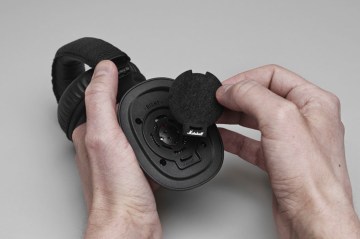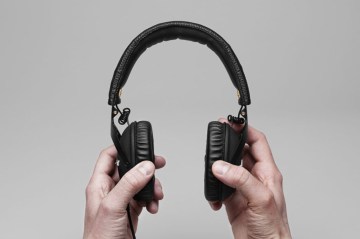It’s possible — heck, even probable — that you’ve heard of Britain-based sonic powerhouse Marshall before. After all, the company’s guitar amps are practically iconic in music-dom. Take its “Bluesbreaker,” which you probably haven’t heard of by name, but you’ve almost surely heard it — well, if you’re familiar with Eric Clapton’s little 1966 album with the Bluesbreakers, anyway. And don’t forget the “Marshall stack,” the holy-holy for concert rock gods who like to raise up literal walls of overpowering sound composed of Marshall amplifiers.
But headphones? That’s newer territory for the company. Marshall’s initial stabs at consumer-grade headphones emerged in 2010, the so-called “Major” (on-ear) and “Minor” (in-ear), neither of which I’ve had a chance to test, but were well-reviewed just glancing around the interwebs. The company’s new premium-priced Marshall Monitor headphones drew my attention because I’m more interested in enthusiast-caliber headphones, and at $200, these things definitely qualify as premium-priced in Marshall’s modest if expanding lineup.
Tiny Cans
Out of the Marshall Monitor’s distinctive cube-like box, you’ll pull a rough canvas carrying pouch with drawstrings (bearing Marshall’s logo), a detachable cord (with integrated microphone) that’s partially coiled like a vintage guitar cable and the collapsible headphones themselves, the cans tucked neatly beneath the headband cushion. From headband to ear cushion bottom, these things are small — much smaller than you’d expect a $200 pair of headphones with “monitor” in the product name to be.
That’s part of Marshall’s marketing pitch: a pair of headphones that “deliver superior noise isolation without the bulk.” To accomplish this, the company employs a custom 40mm driver, 42-ohm impedance, 99dB SPL sensitivity, 10Hz-20kHz response and something Marshall’s dubbed F.T.F, or “felt treble filter” — basically tiny felt pieces tucked into the cans you can remove at leisure if you want a crisper sound in the 1k-20k range. Marshall describes the F.T.F.-in sound as “warmer, laid back” versus “brighter and clearer” when removed, which as usual depends on the sort of audio you’re listening to. The ear cushions are secured magnetically, so removing them is as simple as gripping part of the cushion and gently tugging it off. The felt pieces — also sporting Marshall’s logo — fit snugly into a circular space about the size of a half-dollar piece, attaching via tiny slip-over nubs.
So How Do They Sound?
With the inserts in, what Marshall defines as “warmer” actually sounded more like “slightly muffled” to me, particularly with high-frequency percussive sounds, though the inserts did tend to mellow brighter instruments — it takes some of the ringing harshness from Glenn Gould’s 1981 recording of the first variation from Bach’s Goldberg Variations, for instance, where Gould’s intentionally coaxing harpsichord-like sounds from a CFII Yamaha Concert Grand. But pop the felt pieces out and you can instantly hear sonic details the F.T.F. system masks — crisper highs and general sonic clarity across the spectrum.
It’s something of a subjective preference, of course: I prefer clarity above all, but others may prefer the meatier sound that leaving the inserts in offers. Queue something like Justin Timberlake’s “Suit & Tie,” by contrast, and you’ll find the bass a trifle thumpier, the mids pulled together and less distinctive. Without the F.T.F. inserts, the Monitors produced exceptionally clean audio that compared favorably to my pair of AKG K240 Studio headphones — headphones celebrated for their accuracy (and flat response). With or without the F.T.F. inserts, the Monitor headphones provided reasonably good sound isolation: key-clicks on my MacBook Pro were completely inaudible listening to music while typing this (and only just audible with nothing playing at all).
On Your Head
Fit-wise, I left the Monitor headphones on for an evening, both listening to lossless digital music through my Apogee One and plunking away at my Yamaha AvantGrand (hybrid piano) essentially pain-free. If you wear glasses, as I do, you may experience some above-ear pain over time from the cans torquing on the glass frame arms, but no one in the over-ear market has that figured out, given all the potential frame types and head shapes.
Less important but worth admiring is the overall design of the headphones themselves, with black vinyl leather cupolas and Marshall’s embossed white logo furnishing the distinctive Marshall look. In lieu of hard-to-see “left” and “right” ear placement lettering, Marshall has bolted tiny gold colored placards above the headband’s insides, and the earpiece cabling is coiled, just like the detachable cord. Speaking of that cord, Marshall’s placed 3.5mm audio sockets on both sides, allowing you to choose which side to plug into or optionally daisy chain a second pair of headphones and share what you’re listening to.
Premium Portable
You can find good, often great sounding (relatively flat, well-isolated, reasonably comfortable) headphones in the $100-$200 range everywhere these days, so design and portability become more important distinguishing factors — Marshall’s done a laudable job with both here. I’m less impressed with the F.T.F. inserts, but then how many headphones let you physically tweak their treble-range response (without marring the quality of the headphones to boot)? I wouldn’t use these in lieu of my AKGs for studio work, but if you’re looking for something higher-end and totable, they’re tough to beat.
Marshall Monitor Headphones [MarshallHeadphones.com]



